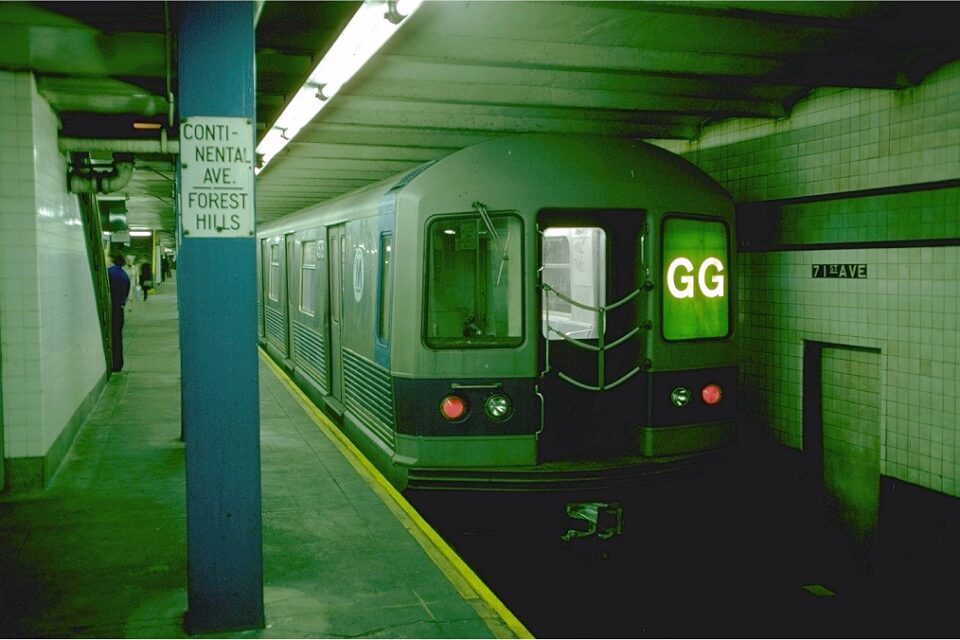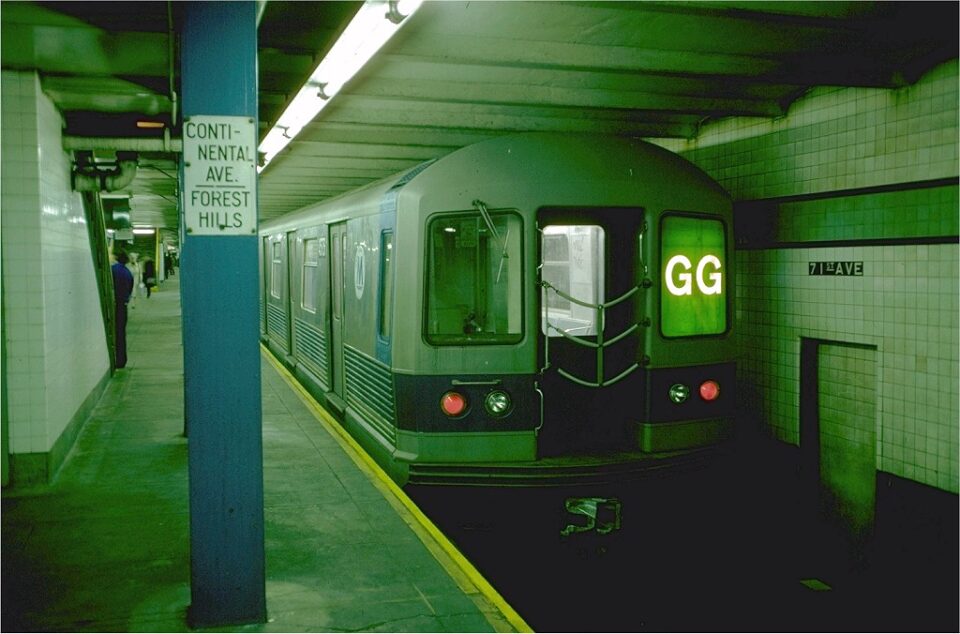
The MTA has recently announced that they will be shutting down the G train in Brooklyn over the summer to install Communication Based Train Control (CBTC) signals, an upgrade over the signals from the 1930s that currently serve the G. The MTA is considering options for how to serve Brooklyn during the shutdown, which will mostly amount to free shuttle buses. None of this is great, but it is necessary. During the L train shutdown to rebuild the Canarsie Tubes, one track was kept open (this is also how the MTA is rebuilding the 63rd St Tunnel). Here, the G will be shut down in sections, from Court Sq to Bedford-Nostrand, and then from Beford-Nostrand to Hoyt-Schermerhorn.
Yesterday, State Senator Kristen Gonzales, who represents Long Island City, Greenpoint, and parts of Midtown East, and State Assemblymember Emily Gallagher, who represents Greenpoint and parts of Williamsburg, sent a letter to Janno Lieber, Chair and CEO of the MTA. In this letter, they ask that the MTA commit to certain long term upgrades to the G train. Namely, they want to see full-length trains (current G trains run with 4-car sets) and they want to see the G train return to Forest Hills.
As someone who lived and worked off the G train, I can say that I have seen first had the growth in ridership over the years. Extending the G to Church Ave and cutting the G back to Court Sq has increased reliability on the line significantly, though, I still find Manhattanites who refuse to believe it. Running full length (8 or 10 car) trains would be very helpful during the day, but even on a Saturday night in Williamsburg, the G can still get away with running shorter trains. Extending the G back into Queens is a much harder ask.
Background
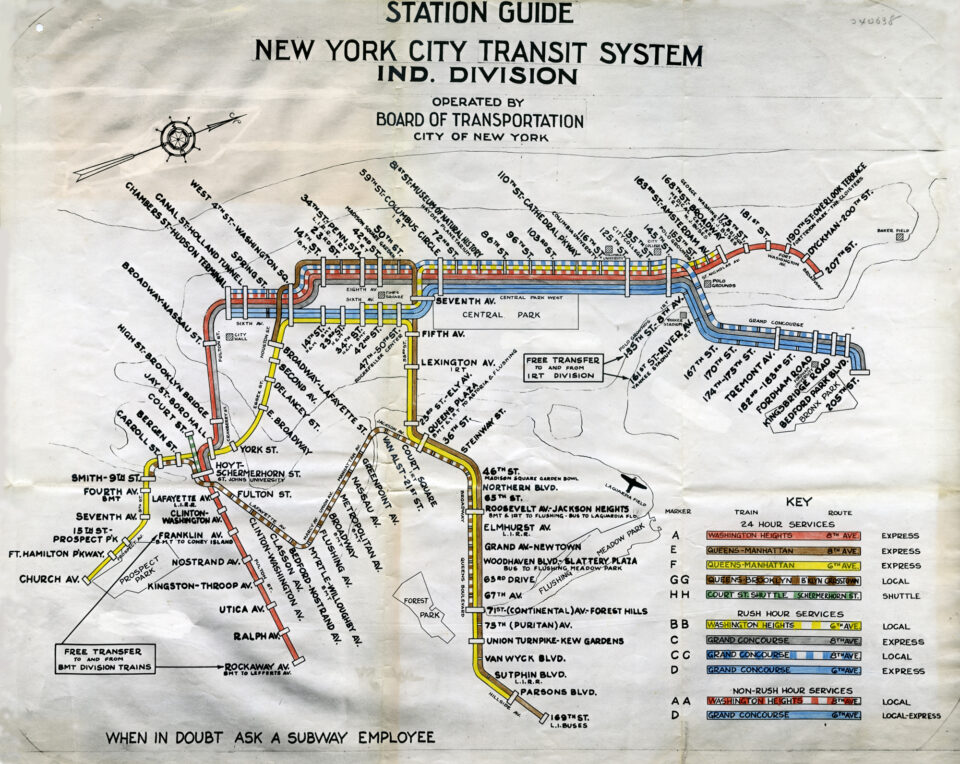
The G train (originally the GG train) was one of the original IND subway lines built in the 1930s. The G connected the IND’s South Brooklyn Line with the Queens Blvd Line. The concept worked on paper: run all express trains into Manhattan, and the G will serve as the local for both lines. Except in reality, far more people wanted to get into Manhattan, so G trains were light on passengers and the express trains, E and F) were always packed.
To mitigate this, the Transit Authority connected the 60th St Tunnel to the Queens Blvd Line in 1955, which allows the R train to get from Broadway to Forest Hills. Initially, this service was called the EE (the local version of the E), then it was the N train, finally the R. But because the R train shares the 60th St Tunnel with the N and W, service is limited. In the 1960s, planners started to design a new tunnel between Manhattan and Queens that would provide more service to Queens Blvd.
The 63rd St Tunnel was initially intended to connect both to the Queens Blvd Line while also connecting to a new, 2-track line that would have been built alongside the LIRR to Forest Hills; the super-express bypass. Work on the 63rd St Tunnel ground to a halt during the city’s fiscal crisis of the 1970s, and the super-express bypass was outright cancelled. The 63rd St Tunnel, with new stations at Lexington Ave, Roosevelt Island, and 21st-Queensbridge, opened in 1989. But it wasn’t connected to the Queens Blvd Line until December 2001.
The MTA looked at various different service patterns for the new line, ultimately deciding on having the F train serve the line full time. To replace the F along the 53rd St Tunnel, a new V train was introduced. The F would still be express, but the new V would be local, running from Forest Hills to 2nd Ave (East Houston St). There was just one problem with this arrangement: what to do about the G.
Forest Hills is a bad terminal. I will go into detail in the next section about why. Because of limited track capacity, the terminal can only turn 20 trains per hour (TPH). That was fine when it was just the R and G. But with a third service, there wouldn’t be enough space for all three. The MTA decided to have the V run during the day, cutting the G back to Court Sq. At night and on weekends, when the V wasn’t running, the G would return. This worked OK until 2010, when budget cuts forced the MTA to reduce service systemwide. To save money, the G was entirely cut back to Court Sq, and the V train was merged with the M train, which would now run from Forest Hills to Metropolitan Ave.
Forest Hills
To understand why the G can’t return to Forest Hills (full time), we must look at how trains operate on the Queens Blvd Line. While the Queens Blvd Line is a standard 4-track trunk subway, it has a number of complex connections that both help and hinder the line. Local trains run on the outer tracks, while express trains run on the center tracks. The local and express tracks have complex merge points in Long Island City, where all four tunnels that serve the line meet. In Jamaica, two tracks branch off to serve Jamaica Center-Archer Ave, while the four of the main line continue to Hillside Ave and 179th St.
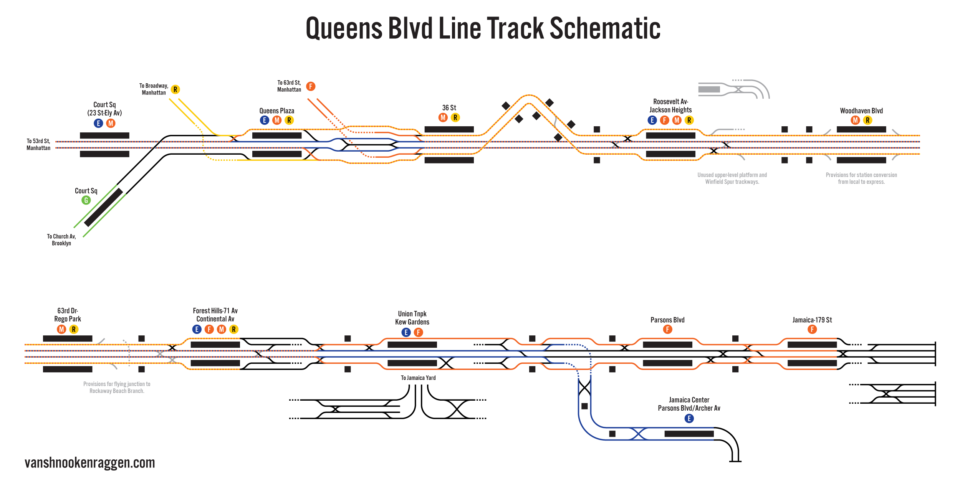
The Queens Blvd Line opened in stages in the 1930s. The first section, from 8th Ave, Manhattan, to Roosevelt Ave, Queens, opened in 1933. The line was extended to Kew Gardens in 1936, along with the Jamaica Yard that was built at the southern tip of Flushing-Corona Park. The line was further extended to Hillside Ave and 169th St in 1937. Plans for further extensions, to Queens Village and a branch along Van Wyck Blvd, were shelved until after World War 2. The 169th St terminal proved inefficient, and a new terminal was built at 179th St in 1950. The Van Wyck branch was repurposed for the Archer Ave Lines in the 1970s, opening in 1988.
The service pattern along Queens Blvd were always designed for local trains to terminate at Forest Hills-71st Av. Past this station, express trains would split so that some ran full express to Jamaica while others would serve the local stations along the way. The track configuration allowed for the extension of regular local service to Jamaica, should that ever be warranted. But in reality, riders from Jamaica would always switch to the first express train they could get, leaving the express trains packed and the local trains relatively open.
East of the station, a third set of tracks merge between the local and express. These tracks lead to a lower level that features four layup tracks for storing and turning trains. These tracks extend all the way to Union Turnpike, where they connect to the Jamaica Yard.
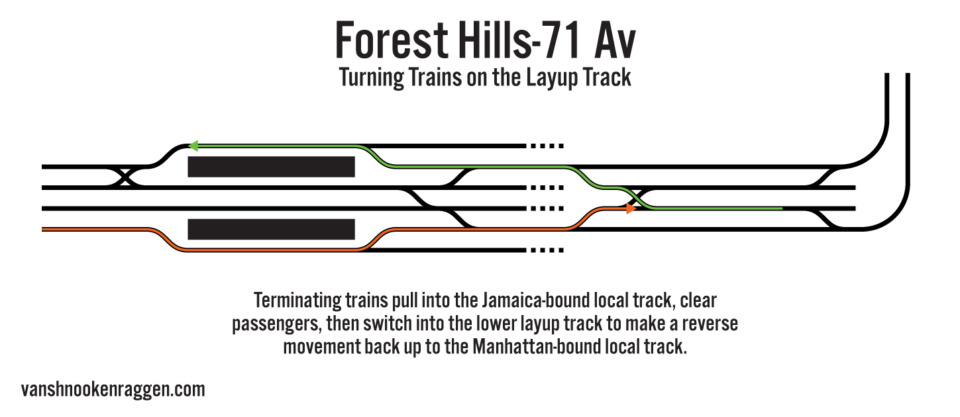
When a subway train enters a terminal station, there are a number of procedures that operators must perform. The train must be emptied of all passengers, and the crew must check the train for anyone still on board, or anything that looks suspicious. If the train is clear, the operator then pulls the train into the layup track east of the station. The switch that connects the local track to the layup track has what’s known as a Divergent Grade Timer. This is a mechanically enforced speed limit that is there to prevent trains from entering the track so quickly that the train skips the switch and ends up hitting an express train that is merging from the express to the local track.
The entire process, from the train entering the station, fumigation, and the slow move on to the layup track, at-best takes 3 min. At a station that allows trains to terminate on two tracks, this means that trains can enter and leave the station with 1:30 min headways (although, realistically, 2 min headways). There are a number of other factors at play, such as where the switches are located, how fast they allow trains to switch, and how fast trains are allowed to enter a station. None of this matters at Forest Hills-71st Av which only has the one local track to use. Local trains would have to pass in front of express trains to use a second track, which would foul through service. Therefore, the entire local section of the Queens Blvd Line is limited to 3 min headways, which equates to 20 TPH.
While that might not seem so bad, express trains are scheduled at 30 TPH (15 TPH each), and the recently installed CBTC signals that allow trains to run closer together should allow frequencies of up to 36 TPH. Even though the local tracks have CBTC enabled, none of this extra capacity is usable on the local tracks because trains would still be limited to the one track for terminating procedures. Currently, both R and M trains run between 8-10 TPH during the day, meaning that at most they run a combined 20 TPH. G trains also run at 8-10 TPH during the day. While the signal system and the tracks could handle the added G train service, the terminal at Forest Hills-71st Av can not.
Under current service levels, the G train can not return to Forest Hills during weekday service. It would be possible to return to weekends and nights.
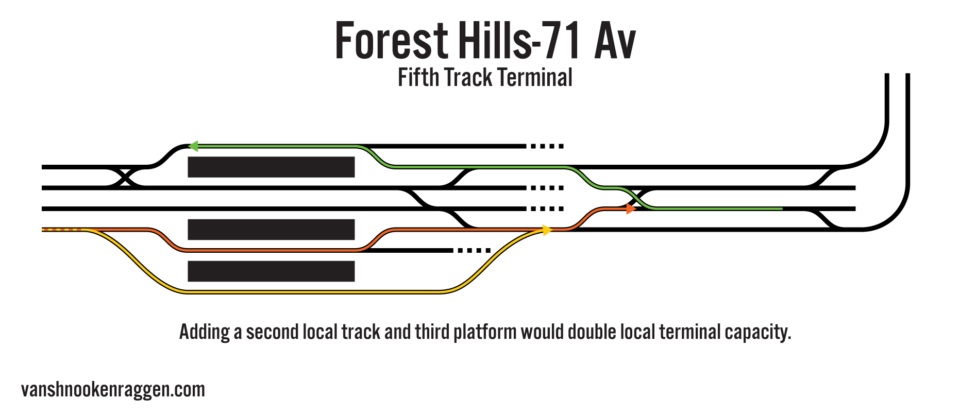
One possible solution at Forest Hills would be to add a third platform, and fifth track, on the Jamaica-bound side. This would allow local trains to access two tracks instead of one, doubling capacity. The fifth track would immediately dive under the Jamaica-bound local track to access the layup yard on the lower level. The Queens Blvd Line was build down the center of Queens Blvd, which is more than wide enough to add such a platform and track. This would, however, be a rather expensive solution, and the additional platform and track would only need to be used during the day.
Is Deinterlining the Solution?
The question becomes, if there is unused capacity on the line, is there a way to reroute trains that would open this capacity up? The Queens Blvd Line has one of the most complex service patters of any NYC subway line. The line serves:
- 8th Ave E train, which runs express from 53rd St to Jamaica Center-Parsons/Archer Av during the day, and the same route as a local train at night.
- 6th Ave F train, which runs express from 63rd St to Jamaica-179th St, but serves the local stations between Forest Hills-71st Av and 179th St.
- 6th Ave M train, which runs local from 53rd St to Forest Hills-71st Av during the day and does not run at night or weekends.
- Broadway R train, which runs local from 60th St to Forest Hills-71st Av during the day and does not run at night.
As this is written, the MTA is currently rebuilding the track bed through the 63rd St Tunnel. This work required the rerouting of F and M trains. M trains now terminate at 57th St/6th Ave, F trains run to Queens through the 53rd St Tunnel, and a shuttle train operates between Lexington Ave-63rd St and 21st St-Queensbridge. For purposes of explanation, I will assume that the original service pattern will remain after work is complete, though some have speculated that the F and M swap will remain in place.
We must also look at the capacity of these crossings to understand which changes might be possible. All TPH are listed at rush hour service.
- 53rd St Tunnel: E trains at 15 TPH, M trains at 9 TPH
- 60th St Tunnel: N trains at 9 TPH, R trains at 10 TPH, W trains at 7 TPH
- 63rd St Tunnel: F trains at 15 TPH.
With current service levels, the 63rd St Tunnel has the most unused capacity, at 50%. 53rd St has 20% unused capacity. 60th St has about 14% unused capacity (though with three services merging and older block signals, 60th St is basically at capacity).
Interlining is when multiple branches run along a single trunk line. When trains merge with the trunk, they slow trains behind them. With deinterlining, you simplify these routes and reduce or eliminate merge points. Merge points require all trains to slow or stop to allow for a train to move from one track on to another. This causes delays, and the added time it takes for trains to change tracks can eat into capacity. Merges might add between 30 seconds and a minute to run times. This is time that can be accounted for in scheduling. But if there is a delay on any service, that delay then cascades into the other trunk lines throughout the system. Additionally, on lines that require higher levels of service (such as the Queens Blvd express), every second counts. If merge delays add up to an extra 3 minutes between trains, that is a loss of 33% capacity.
In the case of the Queens Blvd Line, there are a number of merges.
- M trains merge with E trains at 53rd St/5th Ave.
- M trains merge with E trains at Queens Plaza.
- R trains merge with M trains at Queens Plaza.
- F trains merge with E trains between Queens Plaza and 36th St.
- F trains merge with E trains after Forest Hills-71st Av.
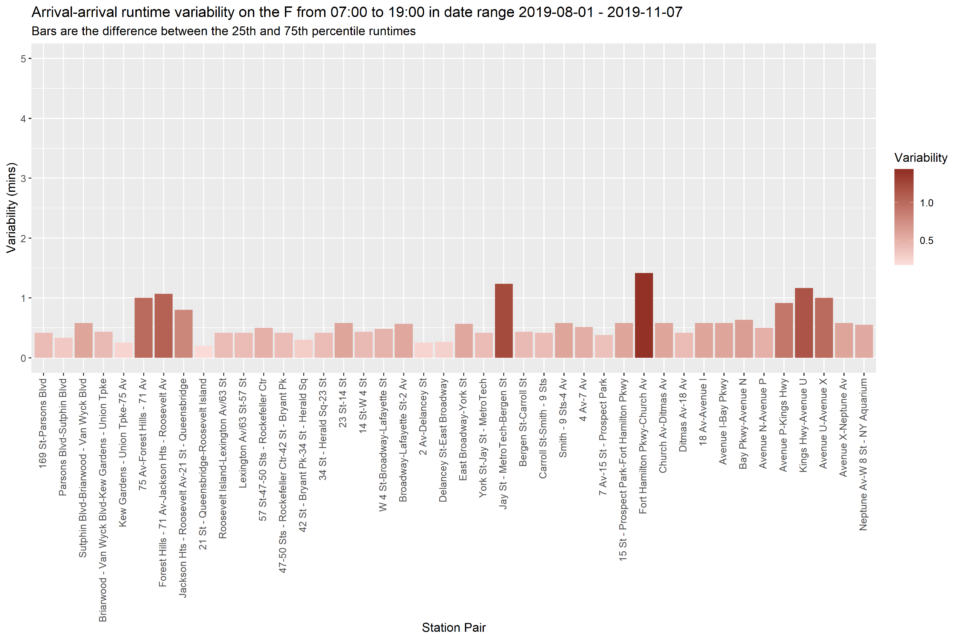
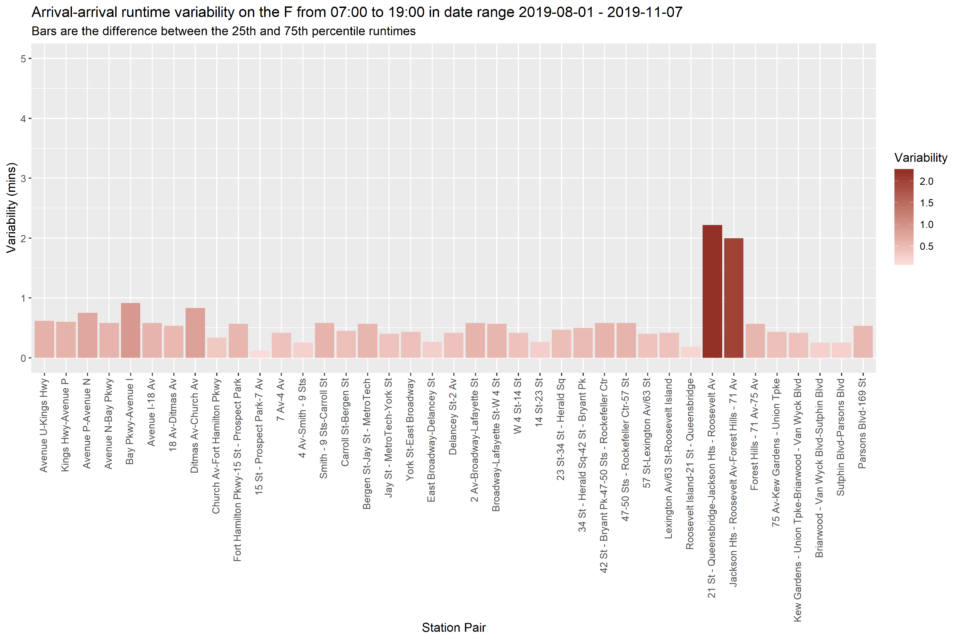
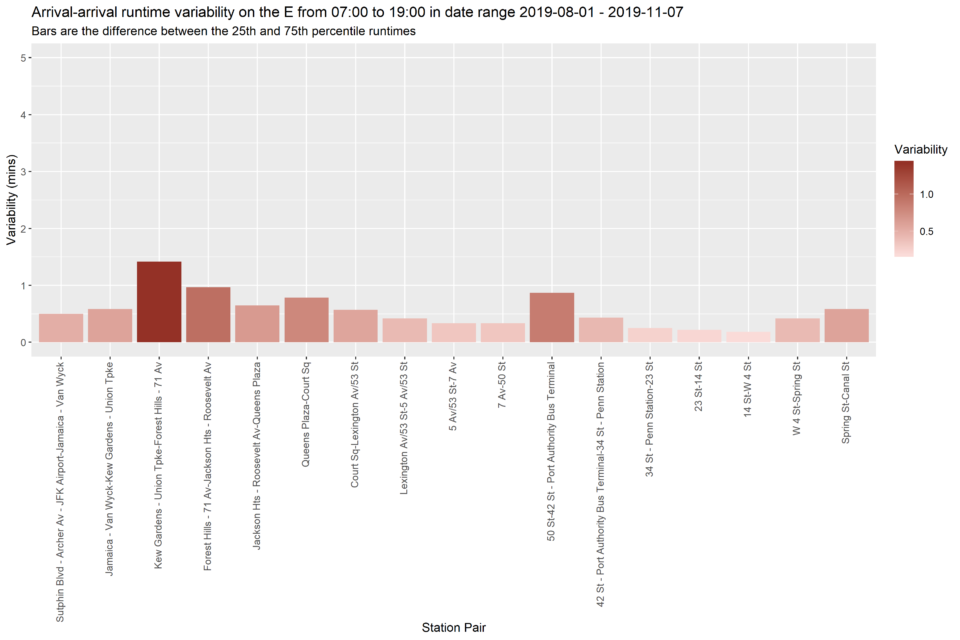
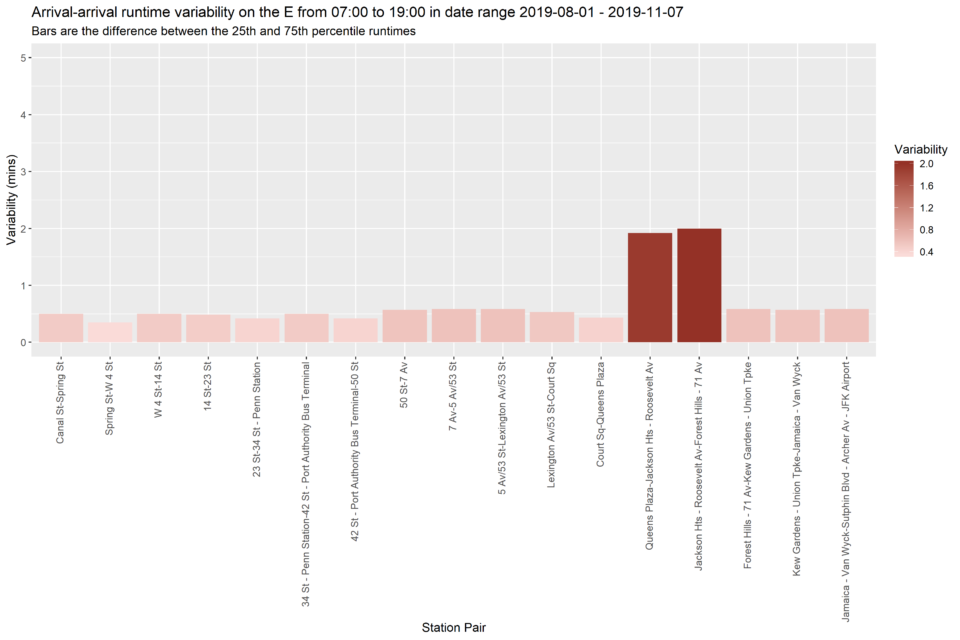
These charts, using MTA GTFS data, analyze the variation in arrival times at certain stations. These charts show the E and F trains in both directions. The higher and darker the line, the more variation in time. More variation means there were delays of some type. If we compare these charts with the track schematic, we can find many of the culprits. In addition to merge points, the Roosevelt Av station has often been a point of delay where riders are holding trains as they transfer between the local and express.
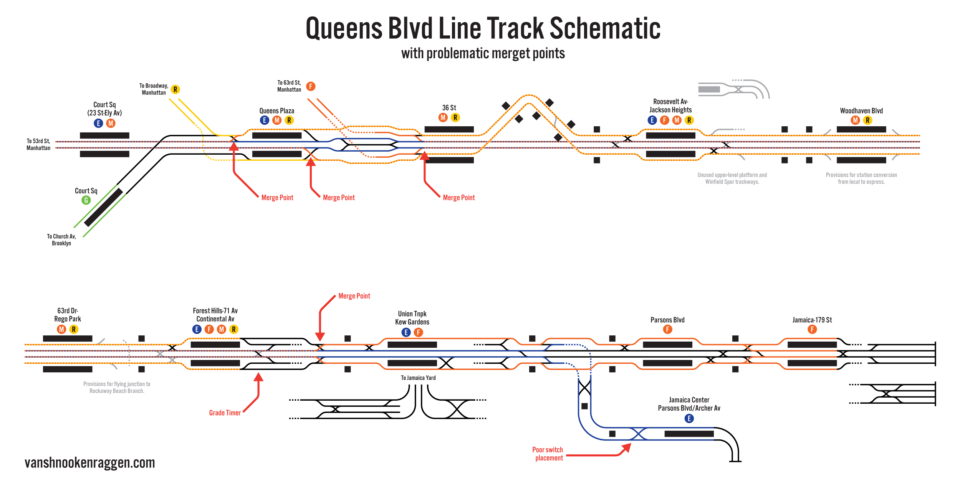
Can we rework the lines along the Queens Blvd Line to free up space for the return of the G train to Forest Hills? Let’s go line by line.
The first line to consider is the R. The R serves the Broadway trunk line, which runs only a block away from the 6th Ave trunk line. This seems redundant, when there are two 6th Ave services on Queens Blvd. But the R serves one very important function: connection to the Lexington Ave express. The R is the only Queens Blvd train that allows a direct transfer to the 4/5 trains at 59th St. The E/M provide a transfer to the local 6 train at 53rd/51st St, but this is an arduous transfer up a long set of escalators, and a two block walk to a crowded 51st St station. Technically, there is a free out-of-system transfer between the F and 4/5/6 at 63rd St, but the four block walk is something of a dealbreaker for most. The R, on the other hand, provides a better transfer at 59th St to either the local or express. The other alternative for an east side transfer is to take the 7 at Roosevelt Ave and transfer at Grand Central. But both of these stations are highly congested, making transfers more difficult.
The M, like the V before it, isn’t the most popular service on Queens Blvd. It runs only 8-car train sets due to the shorter platforms on the Myrtle Ave Line in Brooklyn. The M doesn’t run on weekends either. Because the M provides an alternative to the L train in Williamsburg and Bushwick, it is a better fit running along 6th Ave than its old route downtown. Since the M has to go somewhere after 6th Ave, it would be possible to reroute the M up to 96th/2nd Ave. The F would interline with the M until Lexington Ave, then continue to Queens, while the M would switch tracks and interline with the Q to 96th St. While technically possible, this immediately reduces service between 53rd St and Queens, which is where the majority of traffic is headed. While the Q has proved popular along 2nd Ave, it’s not exactly bursting at the seams and requiring the addition of another service. The merge at 63rd St would simply add delays to the Q.
The E could be expanded to take over all Queens Blvd express duties along 53rd St, though this would require splitting E service in Jamaica (possibly a new service like the K could take over one of the lines). The Parsons Blvd station on the Archer Ave branch of the Queens Blvd Line was not intended to be a terminal station, and the location of the switch entering the station is too far away. This limits capacity there to 12 TPH. At rush hour, the additional trains are run out of 179th St.
If E trains ran at 30 TPH, then F trains could run local through 63rd St, with M trains running to 96th/2nd Ave. This opens up slots for the G to return to Forest Hills. While this arrangement still creates merge points, they eliminate the express-to-local merge at Queens Plaza. F and G trains already interline in Carroll Gardens along the Culver Line, and many times F trains are rerouted along the G when there are delays in Manhattan. This arrangementprovides similar redundancy.
However, there are multiple issues with this alternative: E trains are limited to about 24 TPH at the World Trade Center terminal. E trains could take over the A/C in Brooklyn on the Fulton St Line. But service to Broadway and 6th Ave is now reduced so much that it would create crowding on the F train. Not to mention, the lack of transfers to the 4/5. This alternative moves more trains, but concentrates transfers at already choked stations.
A final option is to extend all local service past Forest Hills-71st Av to Jamaica. The 179th St terminal was built after the crowding issues on Queens Blvd were better understood. A large, 8-track layup yard was built east of the station. In the 1950s, tests were run to see how quickly trains could be run out of the station, and it was determined that a train could be put into service every 57 seconds. This study found that while the terminal could operate at that capacity, the rest of the Queens Blvd Line could not.
The issue remains that local ridership drops off considerably east of Forest Hills-71s Av. Due to the distance from Manhattan, many local riders will transfer to an express train at the first chance they get. These local to express transfers cause trains to sit in stations longer , delaying them. Running all local trains to 179th St requires each line to use more trains and have longer shifts for operators. This costs real money that will not be recouped by higher ridership. Additionally, even though 179th St allows for multiple tracks to be used to terminate trains, the switch layout at 179th St is still not ideal for terminating local and express service together. Theoretically, extending local trains to 179th St would be a wash in terms of capacity because express and local trains would need to pass in front of one another. Running some trains to 179th and others to Forest Hills still has to contend with the poor operations at Forest Hills, so you can’t split the difference. There are other alternatives, but all have the same downsides. More merges, less service to where people want to go, worse trade-offs.
The only workable alternative is to extend the G to Forest Hills-71st Av on weekends, like it did between 2001 and 2010. Care would have to be taken in how such a service is advertised. When this service did run, the subway map showed the G with a dashed line. This style has also been used to indicate rush-hour only service, so some kind of weekend-only style would need to be agreed upon. Having specific services only run on the weekends will always cause confusion no matter what, so it will remain to be seen if such a service is worth it.

The final factor is money. The MTA has gotten away with shorter G train sets for decades. This allows them to use the train cars they need where ridership is higher. New trains are being ordered, but factoring in the extra cars for the G adds hundreds of millions to these orders. This, combined with the additional crew required to run the longer trains means that in the MTA’s eyes, paying riders need to justify the expense. Even with the phenomenalpopulation growth in central Brooklyn over the last 20 years, it may not be enough to justify the expense.
Queens Plaza
An idea which is often suggested is to extend the G train one stop from its current terminal at Court Sq to Queens Plaza where riders could more easily transfer to the E, M and R trains. Using the current track configuration, this isn’t impossible, since it would require G trains to switch in front of E trains accessing a layup track located between the express tracks northeast of the station.
If one was serious about creating a better terminal for the G, there is a way. This would involve building two new track connections between the tracks of the E/M at Court Sq and the 60th St Tunnel connecting tracks. This would allow E/M trains to directly access the local tracks without having to merge at Queens Plaza. G train tracks could then be reconfigured to link up with the express track at Queens Plaza, allowing trains to directly access the layup track. This alignment would reverse the Queens Blvd Line service so that the 53rd St Tunnel would only serve the local tracks, and the 63rd St Tunnel would only serve the express tracks.
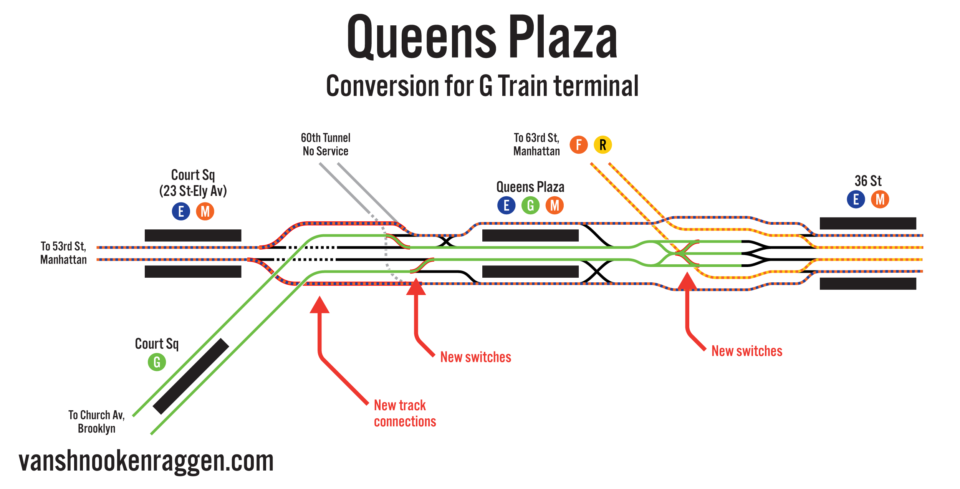
There are issues with this plan. The first is that, since the 63rd St Line does not have a station at Northern Blvd/Queens Plaza, ALL express riders would be cut off from direct access to Long Island City. The alternative may be to require them to take local trains, which would reduce crowding at Roosevelt Ave, but most likely not go over well with riders. It may be possible to add an infill station on the 63rd St Line at 21st St and 41st Ave, right before the tracks make the turn under Northern Blvd. While certainly expensive, the growth of Long Island City would mean that an infill station here would have high ridership potential.
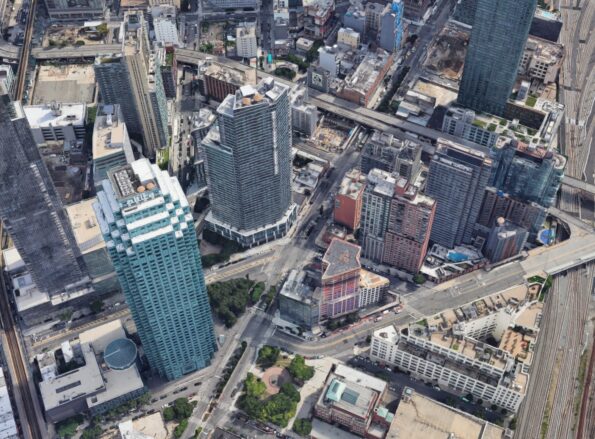
However, this very growth leads to the next issue: high rise buildings in the way. This track connection would be built along Jackson Ave between 44th Dr and 42nd Rd. High rise developments along this section require foundations that are driven deep into bedrock. There may or may not be enough space between the existing tunnel structure and these foundations to slip in these bypass tracks. If there isn’t, it may be feasible to reinforce the foundations, but it would be at great cost.
With E/M trains taking over the track space from the R, the R could be rerouted along 63rd St and replace the N as a Broadway express. Here we face another issue with any deinterlining scheme. If you make one change somewhere, there will be a ripple effect. With this alignment, 8th Ave riders are cut off from express service into Queens, unless they make their way to Broadway or 6th Ave. This plan saves G train riders a few minutes, but hurts far more in the process.
If the G could be extended to Queens Plaza for relatively little cost, it probably would have been done. However, if the project turns out to be more complex and expensive, it will probably never be worth it. The G has a free transfer to the E, M and 7 trains at Court Sq. While some may not like the long walk between the stations, this is hardly the longest transfer in the system and might be the best solution possible.
QueensLink
I would be remiss if I didn’t mention my project, the QueensLink. As part of the project, which aims to extend the M train from Queens Blvd to the Rockaways along the abandoned Rockaway Beach Branch, we propose extending the G to Forest Hills-71st Av. With the reroute of the M train, the slots at Forest Hills-71st Av will now be free to extend the G back. The unusable capacity becomes usable because the M will now branch off before the terminal. Additionally, the QueensLink provides some redundancy should there be delays at Forest Hills; M trains can still serve the Queens Blvd Line while other locals get figured out.
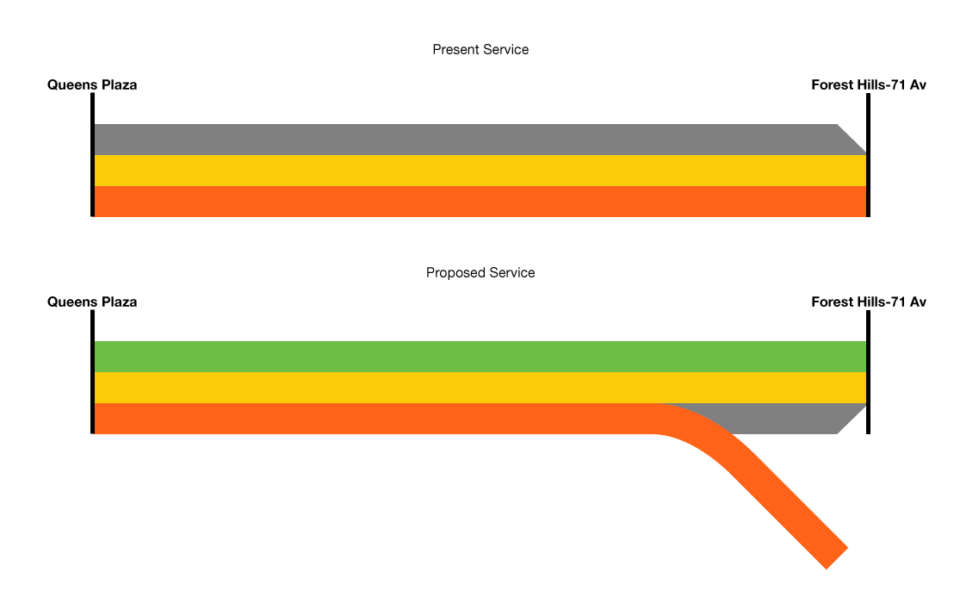
Admittedly, there are some issues with this proposal as well. The merges in Long Island City will be there, though they can be reduced if the F and M are swapped. The G would merge with the R at Queens Plaza, and both would merge with the M at 36th St. The F and E would still merge at 53rd/5th Av, but these merges would be localized. There would be no local to express merge, fouling up both lines. This creates more reliable merge points, so the extra time can be more realistically factored in.
Late night service remains and unresolved. Currently, the F continues to run express along 63rd St to Jamaica, while the E runs local to Jamaica Center. If there was a swap, the F would still need to run along 63rd St at night, or the M would need to run full time. It’s possible to run the M in two sections. The first would be between Myrtle Ave and Metropolitan Ave, as it does today. The other would be from Rockaway via the QueensLink to some station in Midtown.
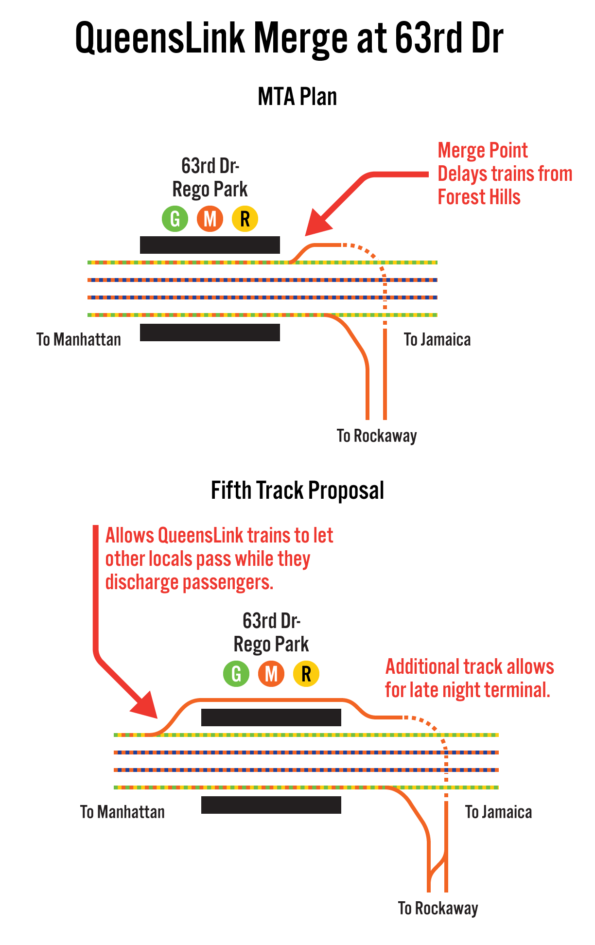
A more expensive, though more beneficial, option would be to add a fifth track to the 63rd Dr-Rego Park station. The Manhattan-bound platform would be expanded to allow the additional track to merge west of the station, instead of east. This would provide a location for late night service to terminate, so riders can transfer to the E. This would also create a better merge point on the Queens Blvd Line where QueensLink trains can wait at the station for local R/G trains to pass before they merge.
All options will need to be further studied by the MTA.
Conclusion
At the end of the day, there really isn’t a way to square this circle. If the majority of ridership is going to Manhattan, then the Queens Blvd Line needs to serve that. Reducing service to Manhattan reduces service in Manhattan. The Queens Blvd Line was built with certain assumptions about ridership that proved to be wrong. Subsequent tunnels were added to address these issues, and in some ways these are still not enough. Even when there are technical solutions to this problem, they often only work when everything is going right. We should be so lucky. It is not impossible to get from the G train to Queens Blvd, just inconvenient. It isn’t so clear that the costs of making this a convenient trip are worth it.
This post was not intended in being a deep dive into interlining vs. deinterlining. Rather, it was to show that there is no perfect solutions to how we route trains on the New York Subway. I’ve been around the railfan community long enough to know how these types of proposals go. Rerouting train lines is a past time for some folks, and many will argue non stop about what the right approach is. I’m keeping the comments off for this post because of this.
Interlining or deinterlining will always have pluses and minuses. Queens simply needs more subway infrastructure to make anything like this a reality.
[UPDATE] This post has been updated with a concept to expand the Forest Hills staiton itself.

